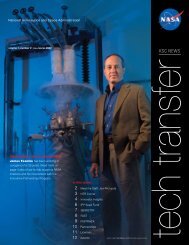2006-2007 - Kennedy Space Center Technology Transfer Office
2006-2007 - Kennedy Space Center Technology Transfer Office
2006-2007 - Kennedy Space Center Technology Transfer Office
- No tags were found...
You also want an ePaper? Increase the reach of your titles
YUMPU automatically turns print PDFs into web optimized ePapers that Google loves.
Parameter Estimation of Lateral <strong>Space</strong>craft Fuel SloshPredicting the effect of fuel slosh on the attitude control system of a spacecraft or launch<strong>Space</strong>craftNutation vehicle is a very important and challenging task. Whether the spacecraft is spinning orModels moving laterally, the dynamic effect of the fuel slosh helps determine whether the spacecraftwill remain on its intended trajectory. Three categories of slosh can be caused by launchvehicle or spacecraft maneuvers when the fuel is in the presence of an acceleration field.These are bulk-fluid motion, subsurface wave motion (currents), and free-surface slosh. Each of theseslosh types has a periodic component defined by either a spinning or a lateral motion. For spinningspacecraft, all three types of slosh can greatly affect stability. Bulk-fluid motion and free-surface sloshcan affect the lateral-slosh characteristics. For either condition, an unpredicted coupled resonancebetween the spacecraft and its onboard fuel could threaten a mission. This ongoing research effortseeks to improve the accuracy and efficiency of modeling techniques used to predict these typesof fluid motions for lateral motion. Particular efforts focus on analyzing the effects of viscoelasticdiaphragms on slosh dynamics.Previous research used MATLAB SimMechanics to model free-surface fuel slosh with a simpleone-degree-of-freedom (DOF) pendulum analog. The pendulum analog modeled a spherical tankundergoing free-surface slosh created by oscillating the tank via an electric motor attached to alocomotive arm assembly. A SimMechanics model incorporating the analog of the experimentwas developed and tested. Parameters describing the simple pendulum models, such as spring anddamping constants at the pendulum hinge location and pendulum length, characterized the modalfrequency of the free-surface sloshing motion. The one-DOF model offered insights into free-surfacefuel slosh and served as a stepping stone for the present research. Using the previous experimentalsetup, we tested different liquids undergoing free-surface slosh and estimated the various pendulumparameters using MATLAB’s Parameter Estimator Toolbox.The first step was to experiment with several liquids with different viscosities in order to betterunderstand how that liquid property affects lateral fuel slosh and the resulting pendulum analogparameters. Liquids of varying viscosities and physical characteristics different from water wereused. It was assumed that for higher viscosities, the peak amplitude of the reaction force on the tankwould be lower than the values measuredwhen using water. As predicted, pendulumdamping, which determines the stiffness ofthe pendulum, was the critical parameterwhen comparing the liquids with differentviscosities. The more damped the pendulumhinge, the less peak force there was atresonance. Parameters (such as the sloshfrequency and pendulum length) remainedthe same for all liquids, regardless of theirviscosities. The SimMechanics model wasupdated and adjusted for the simulationusing different liquids. After obtainingexperimental data at three different fill levels(60, 70, and 80 percent) for both glycerineand corn syrup, the data was imported intoSimMechanics, where free-surface sloshconditions were simulated. Figures 1 and2 compare the experimental data and thesimulated data for glycerine and corn syrup atFigure 1. Glycerine: 60-percent fill level, oscillating at 1.75 Hz (unit = lbf).the 60-percent fill level.84 Fluid System Technologies













